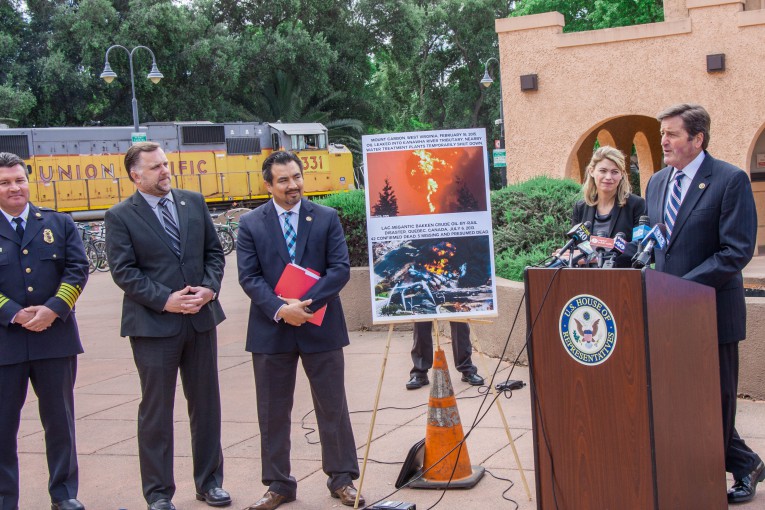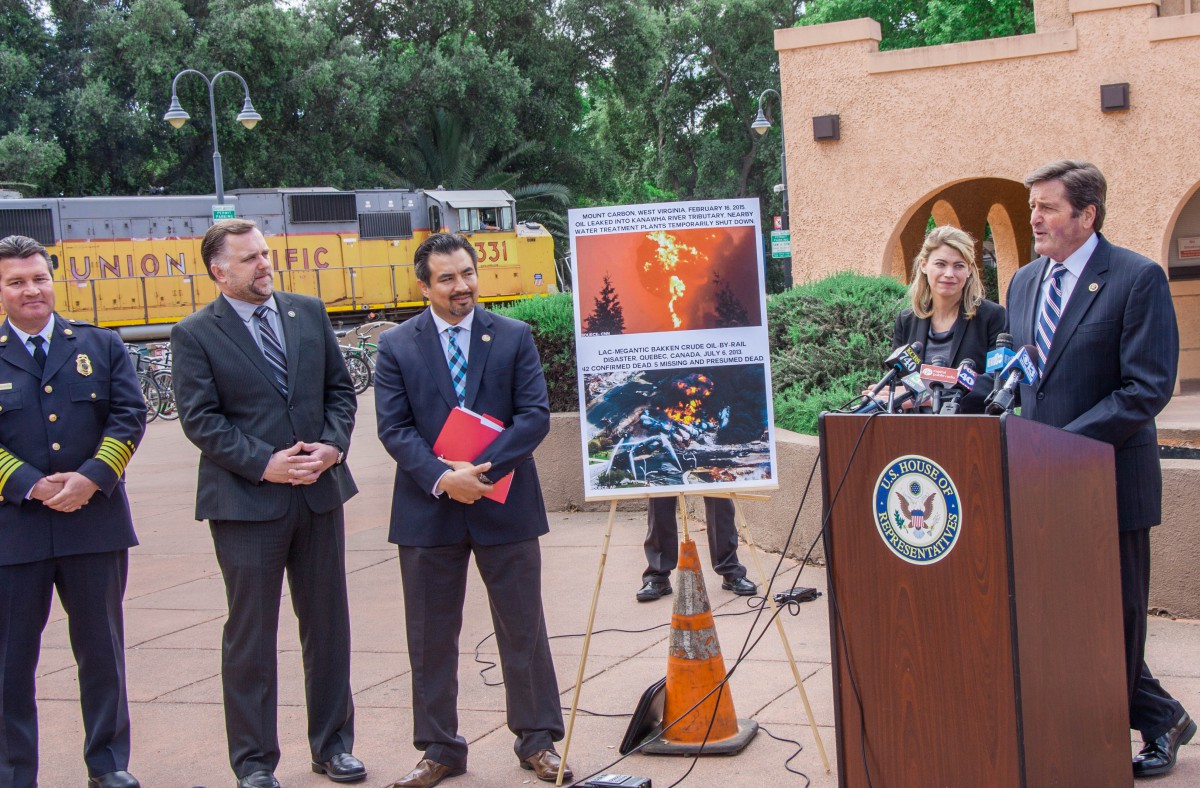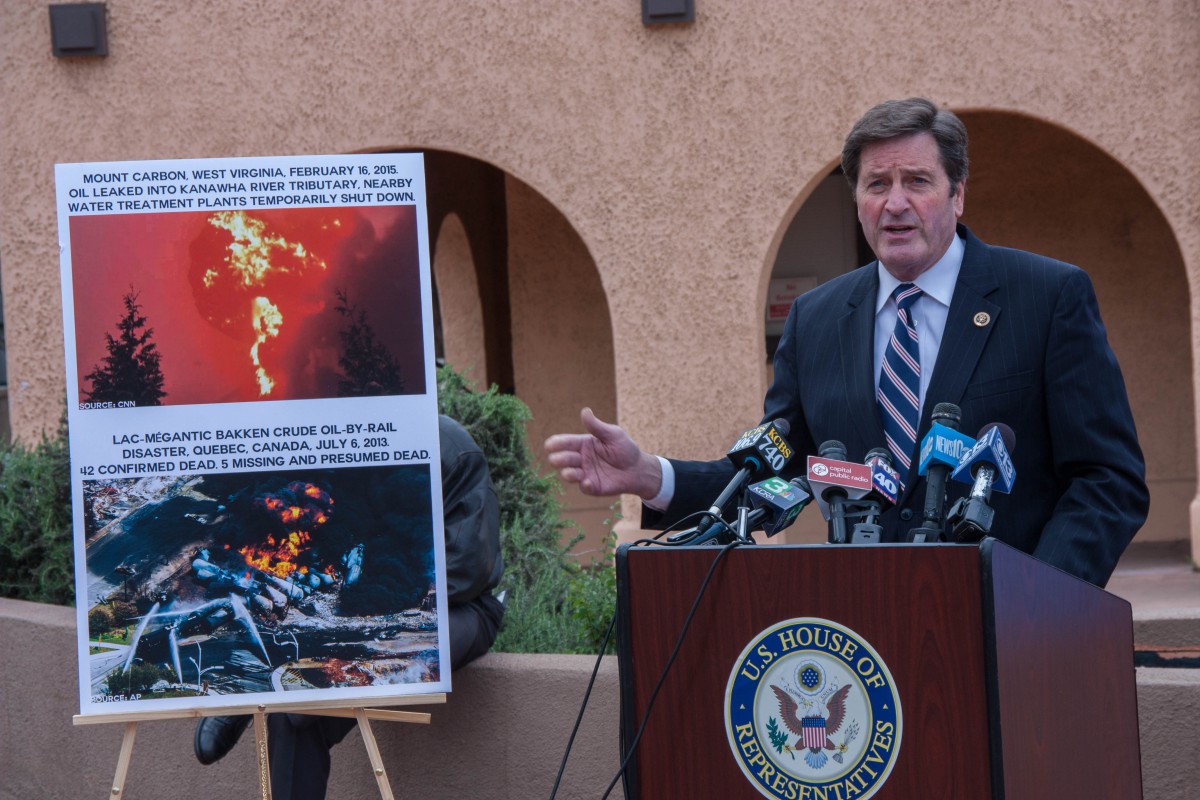

Trains blew through the Davis Amtrak Train Station during a 45-minute press conference. While these trains were not carrying crude oil, it illustrated the close proximity of the rail lines to the everyday bustle of life, as well as to the homes of thousands in Davis and communities like Davis around the region and across the country.
Congressman Garamendi on Wednesday would be flanked by four other elected officials including Davis Mayor Dan Wolk, former Davis Mayor and Yolo County Supervisor Don Saylor, Solano County Supervisor Skip Thomson and Marysville Mayor Ricky Samayoa. There as well were Sarah Feinberg, the Acting Administrator of the Federal Railroad Administration, Paul W. King, PhD, Deputy Director, Office of Rail Safety, Safety and Enforcement Division, California Public Utilities Commission, Eric Lamoureux, California Office of Emergency Services’ Inland Regional Administrator, Dixon Fire Chief Aaron McAlister, Terry Bassett, Executive Director, Yolo County Transportation District, Dana Carey, Emergency Services Manager for the Yolo County Office of Emergency Services, and Don Ryan, Emergency Services Manager for the Solano County Office of Emergency Services.
The press conference was called to urge the implementation of stronger safety standards for hazardous material transported by rail, especially Bakken crude oil. Sensitive infrastructure and 16 million Americans are near these railroad shipment lines.
“Every day we delay the implementation of a stronger safety standard for the transport of Bakken crude oil-by-rail, lives and communities are at risk,” Congressman Garamendi said. “We need the federal government to step in and ensure that the vapor pressure of transported crude oil is lower, making it more stable and safer to transport. We also need to upgrade and ensure the maintenance of rail lines, tank cars, brake systems, and our emergency response plans. My legislation to lower the maximum Reid vapor pressure to 9.5 psi in Bakken-by-rail transport, H.R. 1679, is meant to jumpstart this conversation before it’s too late.”
Mr. Garamendi warned that if one of these trains should derail, “you’d wipe out downtown Davis and possibly hundreds of people.”

“The railroad comprises the geographic and cultural heart of our community – in fact, it is the reason Davis is what it is today,” said Mayor Dan Wolk. “That is what makes this issue – the possibility of so many tank cars filled with Bakken crude oil passing through our community each day – so concerning to us.”
This is not an academic exercise. Valero is proposing the “Crude by Rail Project” which would allow the refinery to receive a larger proportion of its crude oil deliveries by railcar. The Benicia EIR has proposed upgrading of the rail terminal at the Valero refinery to take in as much as 70,000 barrels of crude oil a day.
Last summer, SACOG (Sacramento Area Council of Governments) warned that Benicia “is failing to acknowledge the risks of explosions and fires that could happen if the Bay Area city approves Valero’s plan to run crude oil trains through Northern California to its refinery.”
In June, Benicia’s EIR downplayed the risk of accident, concluding, “The risk of an accidental release of crude oil from a train traveling from Roseville to Benicia is considered insignificant.”
But local leaders are concerned. Yolo County Supervisor Don Saylor, speaking on behalf of SACOG, warned that as many as 5000 Davis residents are in close proximity to the rail lines and could be impacted by a derailment, spill, or explosion.
“It is essential that the federal government act quickly and comprehensively. Public safety is paramount for the half million residents of our region who reside in close proximity to rail lines,” said Supervisor Saylor.

“While oil by rail may provide some significant economic benefits for our county, we must be wary of its potential harms. As elected officials we must ensure that the necessary safeguards are in place to regulate this operation and protect our communities,” said Supervisor Skip Thomson.
In July 2013, a crude-by-rail derailment in Lac-Megantic, Quebec, Canada, killed 47 people. Several major accidents have occurred in the United States since then, including in Virginia, West Virginia, and Illinois. Fortunately, these accidents occurred in locations sufficiently far away from population centers that fatalities were avoided. Had they occurred in the middle of a city like Davis, a disaster on the scale of Lac-Megantic, or worse, could occur.
However, a recent accident damaged just two cars in the derailment, but another 13 cars were destroyed in a subsequent explosion.
In a February 27 letter to Timothy Butters at the U.S. Department of Transportation and Sarah Feinberg, who was at the press conference, Congressman Garamendi together with Congresswoman Doris Matsui wrote that “despite increased train car derailments and an overall delay in the issuance of oil-train safety regulations, the Department of Transportation (DOT) may be considering a revision that could delay the deadline for companies to comply with important safety guidelines, including upgrading CPC-1232 tank cars to new standards. Considering the frequency by which derailments are occurring, we believe that other measures.”
They wrote, “Serious crude-carrying train incidents are occurring once every seven weeks on average, and a DOT report predicts that trains hauling crude oil or ethanol will derail an average of 10 times a year over the next two decades, causing billions of dollars in damage and possibly costing hundreds of lives.”

HR 1679 “would prohibit the transport of Bakken crude-by-rail unless it has a maximum Reid vapor pressure (RVP) of 9.5 psi. This is the maximum volatility permitted by the New York Mercantile Exchange (NYMEX) for crude oil futures contracts. For context, a recent literature review by Sandia Labs indicates that the North Dakota Petroleum Council’s Study of 152 Bakken crude samples found an average RVP of 11.7 psi and a max of 14.4 psi. A rule will go into effect in North Dakota this month setting the limit at 13.7 psi.”
Assemblymember Bill Dodd was not in attendance at the press conference but sent a statement, “The safety or our residents is of paramount importance. The federal government needs to ensure that the public safety and environment in our communities here and across the nation are protected. Congressman Garamendi deserves recognition for raising the issues surrounding crude oil rail shipments and working towards solutions.”
Likewise, Senator Lois Wolk sent a statement to the media.
“It is key that we tackle this issue at all levels in order to ensure the safety not only within my district, but across the state,” said Senator Lois Wolk. ” In order to improve the safety of transporting hazardous materials by rail, I support Governor Brown’s budget proposal for a fee, that I previously introduced, and is written into this year’s budget for local emergency preparedness. In addition, I have introduced Senate Bill 730 which would require that all freight trains operating in the state be manned by at least two people. This requirement ensures better communication and safety as well as operational efficiency.”
—David M. Greenwald reporting



i understand the issue and i support the cause, but i’m trying to figure out how having a press conference on it in davis was helpful
Where to begin . . .
This is pure political posturing. Garamendi is proposing federal regulations to make transport of oil by rail POSSIBLE, not to stop it. As we have already seen, the “safer” cars also have a tendency to explode when ruptured in a derailment. The industry continues to ship oil by rail despite that actual tests to first determine a “safe” volatility and second to crash and rupture test cars to determine they actually don’t explode, and then build this fleet. A safe fleet (more similar to the crash standards of radioactive waste trains), even if anyone were trying, is a decade in the future. And no one is trying. They are instead proposing legislation to ALLOW the trains to run by setting what are mostly arbitrary standards for rail cars we already know can fail.
As I have stated before, pipelines and/or rail lines could be built around almost all populated areas of the state, even incorporating existing pipelines or railways or rights-of-way. This would be very expensive. However, the cost of just one derailment both in monetary losses, life, and horror, cannot be weighed against this. It is only a matter of time before there is an explosion in California.
Hypocrisy reins. Garamendi is the representative that is encouraging Yolo County and all the cities within to apply for federal money to build this so-called rail relocation (not the oil train route, mind you). One of the major reasons sited is to remove rail crossings for safety. Yet most of the crossings to be removed have a very low accident rate. In addition, at least a dozen major NEW crossings will have to be built and maintained where the new bypass route is proposed. But most important is that the two deadliest crossings in Yolo County, Swingle (east of Davis on Road 32-A) and Arboretum Drive (behind Whole Foods) are ignored in this plan.
Those two crossings have claimed dozens of lives over the years (roughly a dozen in the last 2-3 decades), have involved collisions with vehicles which on occasion can, and in one occasion did, derail a train. And here is the hypocrisy. While Garamendi pushes for this so-called rail relocation, a huge boon for mega-developers, the two biggest rail death spots in the county, both ON the oil train route, which is not proposed for a rail bypass, remain unfunded for grade separation and ignored by Garamendi’s so-called “concerns”. And this goes double for the Yolo County Supervisors and triple for the City Councils of the tri-cities of Woodland, West Sacramento and Davis.
Every ounce of energy wasted on the so-called rail relocation is an ounce of energy that could go toward seeking grade separation at Swingle and Arboretum. But . . . no.
And so the hypocrisy goes on. The most important item, that Garamendi probably has no awareness of, but the council sure does (because I’ve told them numerous times) is the 10mph mainline crossover on the south side of Old East Davis. This crossover is deceptive to train engineers as a red-over-green aspect, which is good for 45mph on most of the crossover with a similar signal aspect, is only 10mph. So, if 99.9% of the engineers remember to slow down, what of the other 0.1%. This isn’t theoretical. I have twice seen Union Pacific F— this up. Once in 2006 with a liquified petroleum gas unit train at 47mph, and once with a manifest train containing flammable placards in 2009. And how many times has it happened when I wasn’t there to witness? While, amazingly, these trains didn’t derail, I have been told by numerous rail-knowledgable people that they very easily could have. This hazard remains, and, along with the at-grade crossings, must be removed.
Garamendi is focused on the federal regs to ALLOW oil trains to run and the so-called rail relocation, which will do nothing for safety on the main line where the oil trains will run. We need to focus on ways to ship the oil by pipeline in California around populated areas, and to upgrade road crossings and rail infrastructure that pose greater-than-normal risks for derailment.
Meanwhile: Lois Wolk. What a transparent nothing of move on her part. Requiring two person crews on freight trains? Freight trains already HAVE two person crews. The rail unions are using the oil train issue to push for legislation to require two person crews, as they wish to protect union jobs. Putting aside if one-person-crews are a good idea or not from a safety standpoint, this is an obvious kowtow to the rail unions, and is of minimum help for oil train safety in the California context.
Everyone needs to get real, and not stop if, and more likely when, oil trains will run. The weird thing about human kind is they’ll first protest, then accept when the actual potential danger is there, as there is, perceptively, no longer a deadline. That is until the dead line becomes the limits of the blast zone of a derailed oil train in downtown Davis.
Burn baby burn.
Yes, grade crossing accidents are a big problem. The Federal Railroad Administration (FRA) statistics show 2280 grade crossing accidents, 267 fatalities, and 832 injuries in the US in 2014. If our politicians really want to do something to improve safety around the railroad, then working to eliminate grade crossings is the obvious place to start.
Wonder what the numbers would be if you removed alcohol related, and/or suicide-by-train incidents.. not sure we can call those “accidents”. @ 105 and Arboretum Drive, that would reduce the fatalities to like 1 or 2 in the last 20-30 years.
“Wonder what the numbers would be if you removed alcohol related, and/or suicide-by-train incidents.”
Huge reduction. However, how do you do that? Caltrain, plagued with suicides, spent tons of money on fencing, guards, suicide prevention signs, and they are having the highest suicide rate this year ever. Even if you seal the right of way, people jump off bridges and passenger platforms, as in Japan and Europe. The theory of means reduction simply fails when it comes to rail suicides.
AM–great info., particularly about the mainline crossover (this seems like a scary situation; glad I don’t live down-momentum from this; as isn’t it near a curve?). Hope you stay involved with this issue and help steer train disasters away from Davis.
Count on it.
But fixing grade crossings would cost money.
Yes, it costs a lot of money. Think about the costs of fixing the damage after an accident and the cost of injuries and deaths as well as destroyed equipment due to accidents.
that was my sarcastic voice. i’m in agreement with you, but using that voice to suggest that politicians will not put resources into such expenditures.
My point is, politicians will spend tons of yours and other peoples money to fund mega-developers, but won’t focus on the true hazards in our town and push for obtaining a fraction of the cost of so-called rail-relocation and instead fight like hell for funds to eliminate the two deadliest crossings in Yolo County and eliminate the 10mph crossover. Davis will be a lot safer if oil trains do start running if those three rail infrastructure weaknesses/hazards are eliminated.
Don’t count on Union Pacific to spend their money on it. They won’t even spend a few hundred bucks to have one of their crews paint out the graffiti on the ugly silver fence they built — a fence they only built when taxpayer money came available to pay for it. Union Pacific cares not a wit about the people along its rail lines.